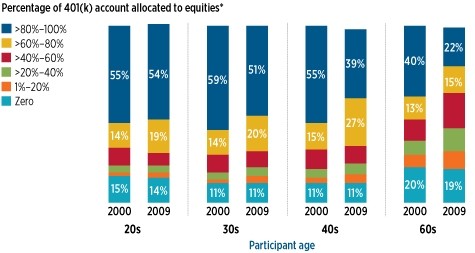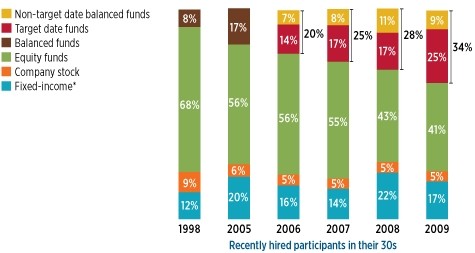ICI Viewpoints
401(k) Plans Help Keep Americans on Track
ICI sees strong evidence that the features of 401(k) plans help Americans avoid overreaction to financial turmoil, by countering extremes in investor behavior that hard times often produce.
This was one of the key points that I made recently at the Ayco Summer InnerCircle Benefits and Compensation Conference in Saratoga Springs, New York. I invite you to look over my full presentation, which contains a trove of data and charts pertinent to retirement policy.
Of course, retirement savers have not been immune to the general decline in risk tolerance, a fact that my presentation addresses.
However, two key innovations in 401(k) plans have helped keep many Americans on course toward their retirement goals. First, automatic enrollment has spread rapidly, creating millions of new retirement savers. And use of target date funds has also grown, particularly as default investment options for those auto-enrolled workers.
As the following chart shows, 401(k) participants in most age groups have reduced the extremes in their asset allocations. Look in particular at the top portion of each bar, the blue. This shows the share of savers who have allocated 80 percent or more of their accounts to stocks. With the exception of the very youngest workers, fewer workers at any given age are in this extreme group in 2009 than were in 2000. Retirement savers have tended to temper their allocations to stocks.
401(k) Participants Have Tempered Their Account Allocation to Stocks
Percentage of 401(k) plan participants by age, 2000 and 2009

*Includes stocks held in funds.
Source: EBRI/ICI Participant-Directed Retirement Plan Data Collection Project; see Holden, VanDerhei, and Alonso, “401(k) Plan Asset Allocation, Account Balances, and Loan Activity in 2009,” ICI Perspective (November 2010)
But they haven’t gone overboard, and we can credit the features of 401(k)s and the growth of target date funds for that. Consider the following chart on workers who were in their 30s and on their current job less than two years at the time of each survey. As you can see from the top segment of each bar, recently hired 30-somethings have steadily increased their investments in balanced investments, from 8 percent of their total assets for the recent hires in 1998 to 34 percent among the recent hires in 2009. The growing role of target date funds—which accounted for one-quarter of this group’s 401(k) plan assets in 2009—is fuelling that trend.
Recently Hired Participants in Their Thirties Hold More Target Date and Balanced Assets
401(k) plan average asset allocation among 401(k) participants with two or fewer years of tenure, percent of total

Note: “Funds” include mutual funds, bank collective trusts, life insurance separate accounts, and any pooled investments product primarily invested in the security indicated. Percentages are dollar-weighted averages.
Source: Tabulations from EBRI/ICI Participant-Directed Retirement Plan Data Collection Project; see Holden, VanDerhei, and Alonso, “401(k) Plan Asset Allocation, Account Balances, and Loan Activity in 2009,” ICI Perspective (November 2010)
It’s numbers like these that bolster our belief in the tremendous success of the 401(k) system and its ability to help millions of American workers prepare for retirement.
Paul Schott Stevens was President and CEO of ICI.
